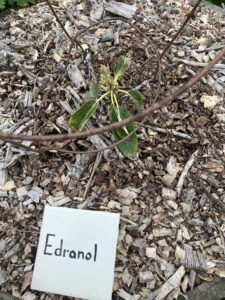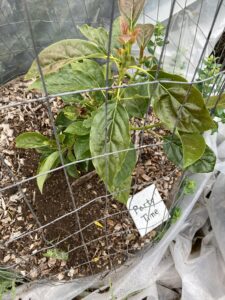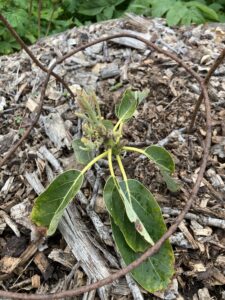Sometimes you have to admit it when someone points out that what you’ve been saying is wrong.
In this case, it’s about growing avocados in containers.
We here at Epicenter have seen what happens to avocados that get left-over after a season. The orphaned, the outcasts, the trees no-one wanted rarely fare well if allowed to languish long in their old pots. The soil sinks down as the wood particles in the potting mix decompose, and the porous structure turns dense and muddy. Who hasn’t seen a yellow, bare-limbed little avocado tree, stunted and stalled-out in an old pot with sow thistle and panic grass hogging the remnants of failing fertility?

When confronted with questions about growing avocados in pots, we say:
Don’t do it!
That is, until reprimanded recently by several super-skillful avo-growers who seem to have identified the pitfalls, and solved the riddle through austere soil mixes that are stable over time and provide the root-zone drainage and oxygenation that avocados require to survive and thrive in the medium and long term.
We were shown photos of lush, dark green avocado trees standing overhead, holding good loads of fruit, anchored in half wine barrels and smaller receptacles.
And who wouldn’t want to grow an avocado in a container if it actually made sense?
Our settled-out response to this revelation is to reluctantly embrace it, but insist upon confirming it through our own experience.
Our informers have been patient and generous with us, and provided us with the tools to replicate their results. And now that we are paying attention, it seems there are suddenly lots of You-Tube videos on this subject, that we had no idea of, because we never really thought it would work.
I still feel an avocado belongs in the ground, but to increase your collection when you’ve run out of space (which we have), or to participate from an apartment balcony, I have to admit that growing an avocado in a pot is way better than not growing one at all.
The common thread between the online videos and advice from actual people we know, seems to be the avoidance of wood, bark or any compostable, organic material in the root-zone, as over time, these things break down and condense.
Microbial break-down of wood particles is a part of the cycle of life, and isn’t bad, especially when it occurs above ground. Nitrogen and other nutritive elements are made available in this process; they enrich the soil, and they feed the tree. When this occurs buried underground, because the resulting ethylene gas given off is contained around the roots and soil oxygen is used up, the effect can be injurious.
Ethylene is toxic to roots, which also require the Oxygen which is instead consumed by the breakdown microbes. Additionally, the reduced particle size of composted wood compacts the soil structure, reduces the oxygen carrying capacity within the pot, and increases water retention to the point where the bottom part of the rootball becomes saturated, and suffocates the roots in anaerobic sludge, even as the top feels dry and in need of irrigation.
In the mix we use for the trees we sell in our nursery, there is a high proportion of wood, bark, and coconut fiber. This works to provide an light, open, loose, aerified structure in the short term. We intend for our trees to get into the ground asap, and it is disheartening to hear of trees still in their pots a year or more after leaving the nursery. In the longer term, the wood particles do break-down and turn sludgy, but if planted promptly, the roots have the opportunity to grow beyond the potting medium, and into straight soil, so the delicate, highly respirating feeders go where they want, to get the things they need. The compromised mix matters little after the roots have moved-on.
We have always recommended growing avos in a well-draining mound, free of incorporated organic material. The advice that follows just extends this same principle to containers.
To test the theory, in our own containers, we used roughly the following mix:
30% Decomposed Granite
30% Perlite
30% Pumice
10% Peat moss
The DG could work as a stand alone potting soil. It is cheap, sustainable, holds water, but drains excess water pretty well, and doesn’t settle or decompose microbially. The reason for the other components in the mix is to increase porosity, and counter the fact that DG is very heavy, and will compact into a base-rock/concrete-like material if allowed to dry out even a little.
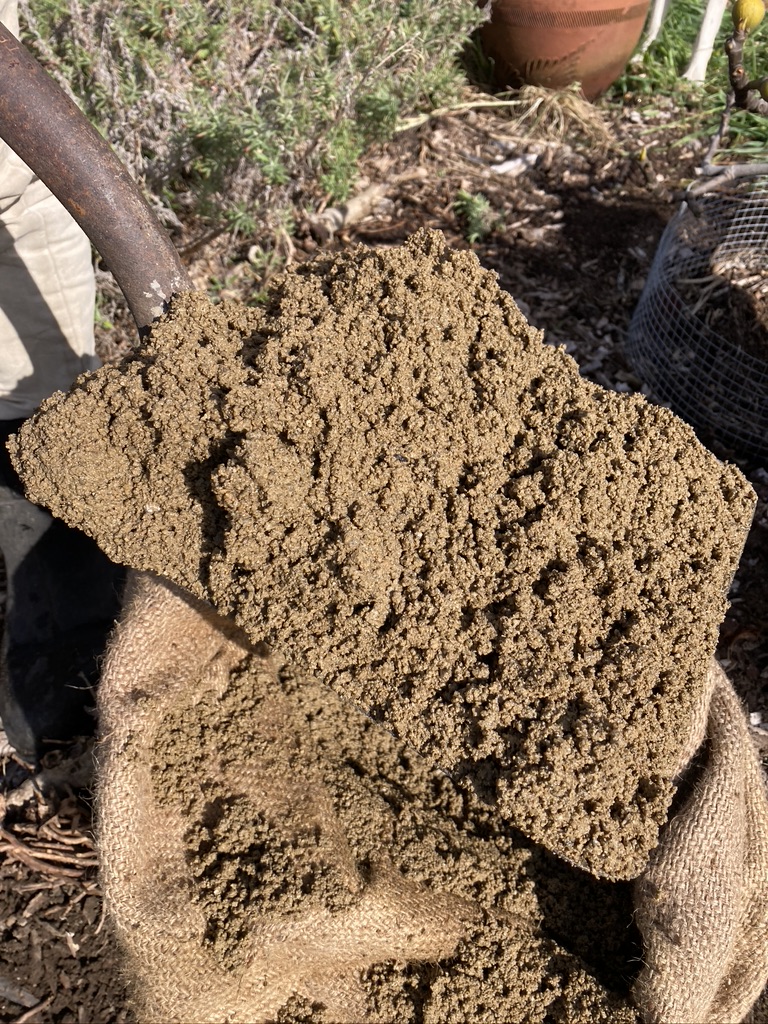
Perlite is expanded obsidian, think rock-popcorn: very light, and roundish in shape, helping to lighten the mix, and counter the tendency of DG to compact. The shape also helps to increase the oxygen holding capacity of the soil, since it creates voids between itself and other particles.
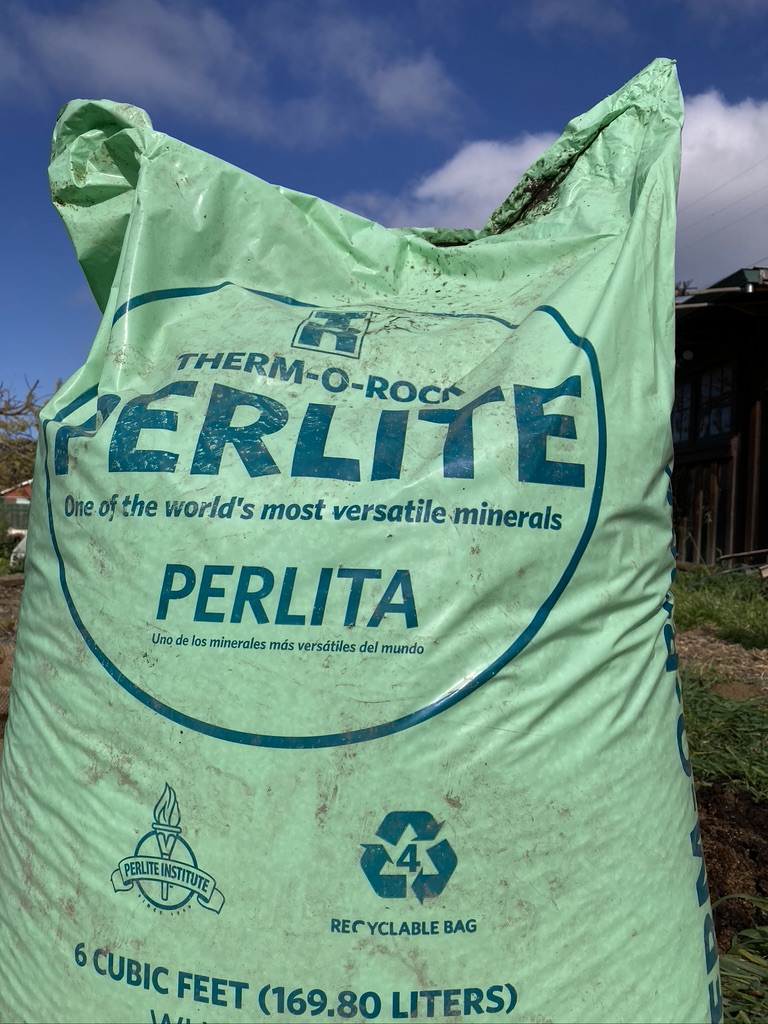
Pumice is a naturally occurring volcanic pebble, very light, porous and rounded. Like perlite it lightens the weight and increases the oxygen carrying capacity of the mix while reducing compaction and increasing drainage and porosity.
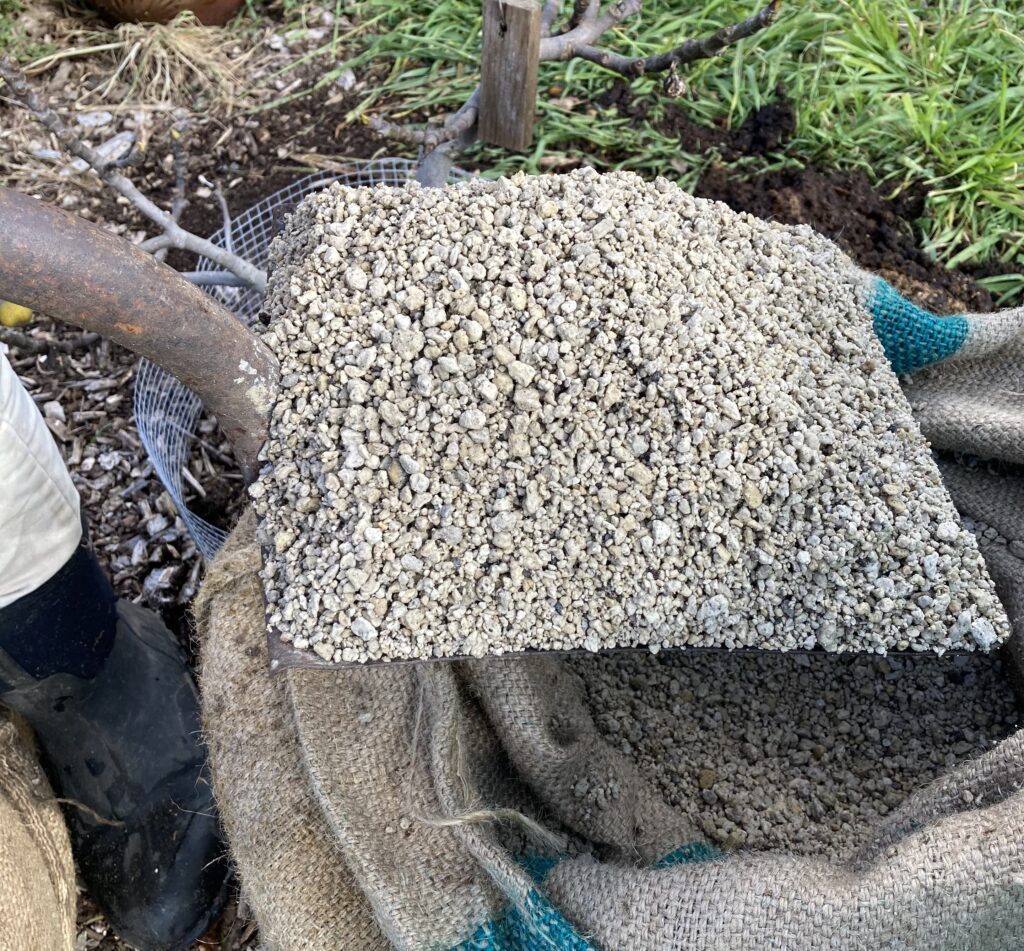
Peat Moss is mined from peat bogs and is probably not a great thing to use when you consider how slow it forms, and how much is sold, but it is very stable and slow to degrade, and helps to hold onto a little water if you’re afraid your mix drains too fast.
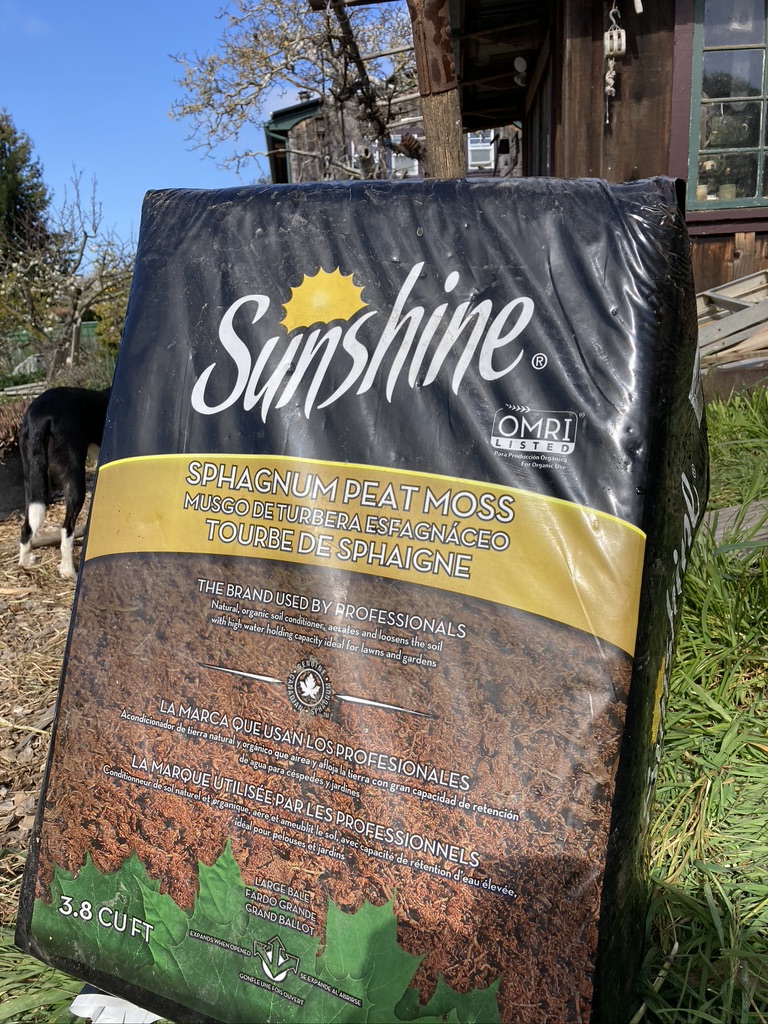
Why add peat moss? Because our gurus told us to. Probably Coconut Coir fiber would be a good replacement for future projects!
We took a half wine cask, which holds about 27 gallons of material, and drilled a bunch of (8-10) holes in the bottom with a one inch auger.
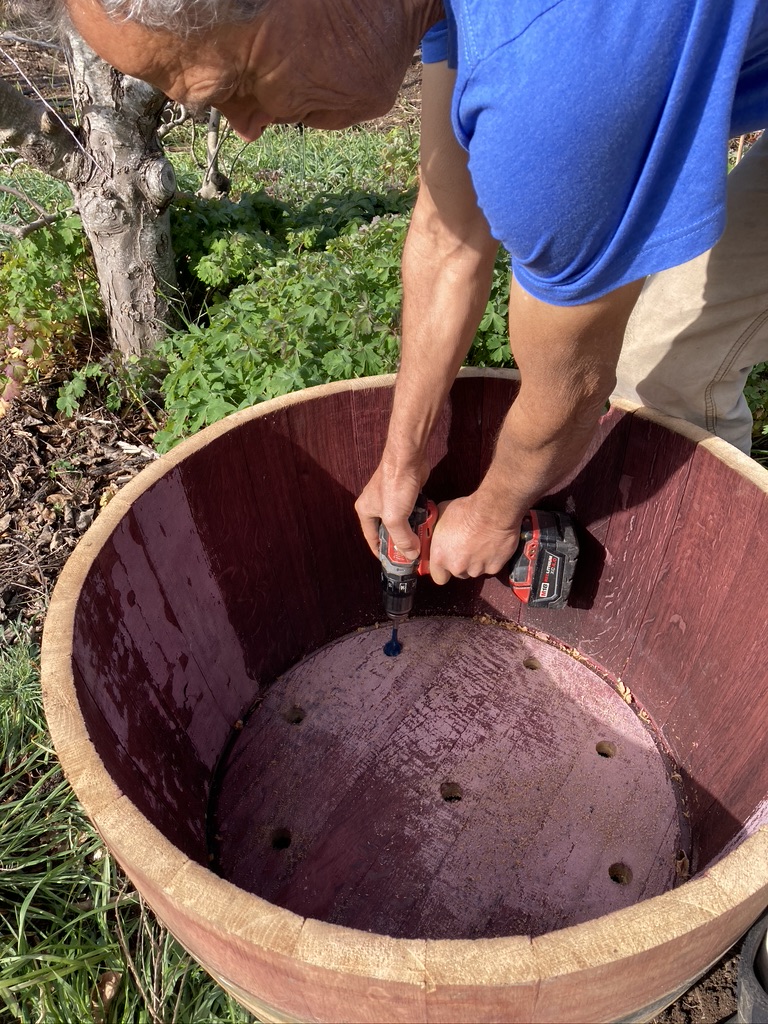
Next we set a few inches of 2” granite drain rock in the barrel, and covered this rock base with a piece of fine window screen. The rock is to improve drainage at the bottom of the pot. The screen is to prevent the potting medium from loading up the spaces between the drain rock and reducing its aerating effect.
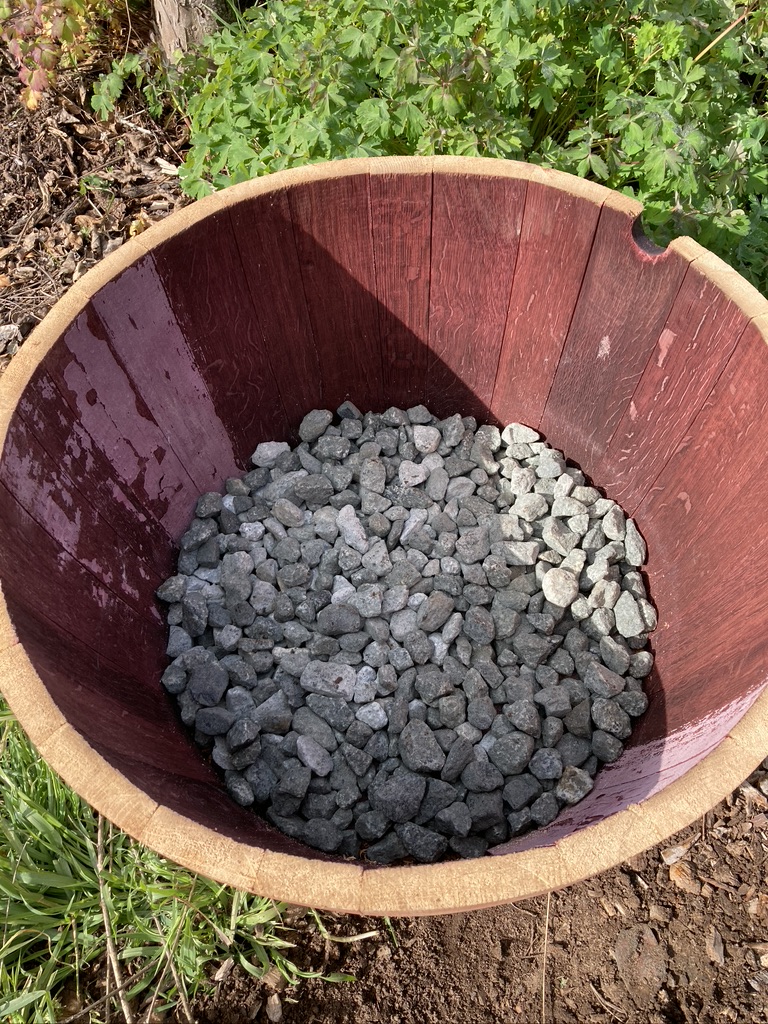
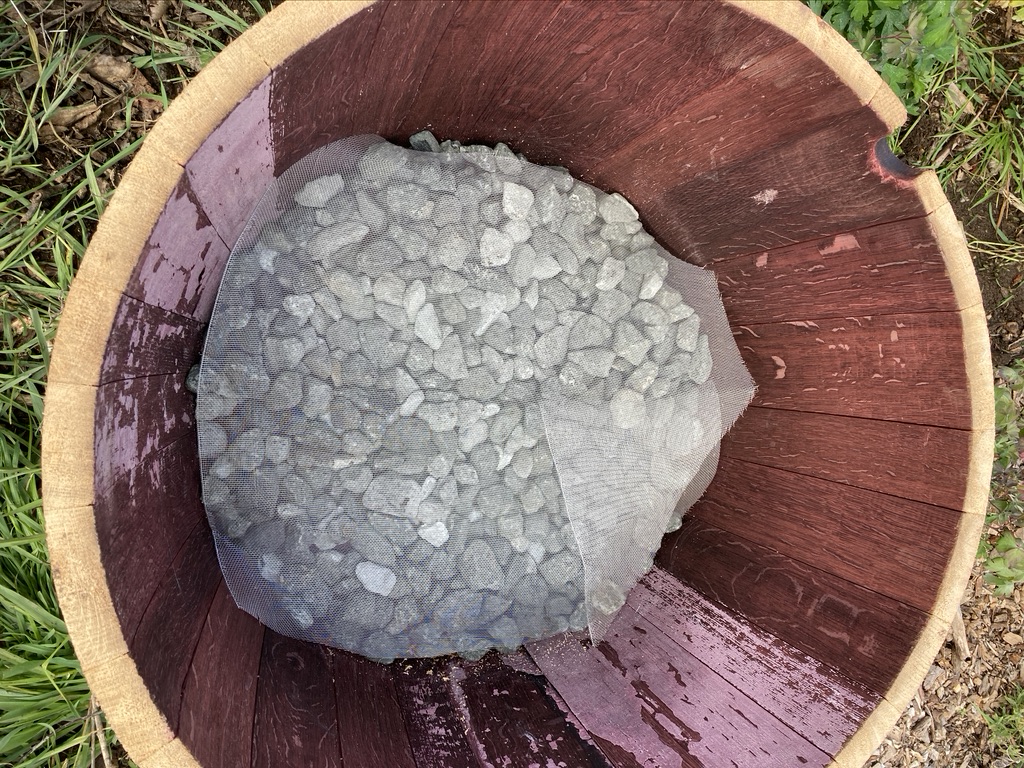
On top of the screen, we combined our materials in a way that concentrated the peat moss into the upper half of the barrel, to hold some moisture, while keeping the bottom lean and perfectly draining.
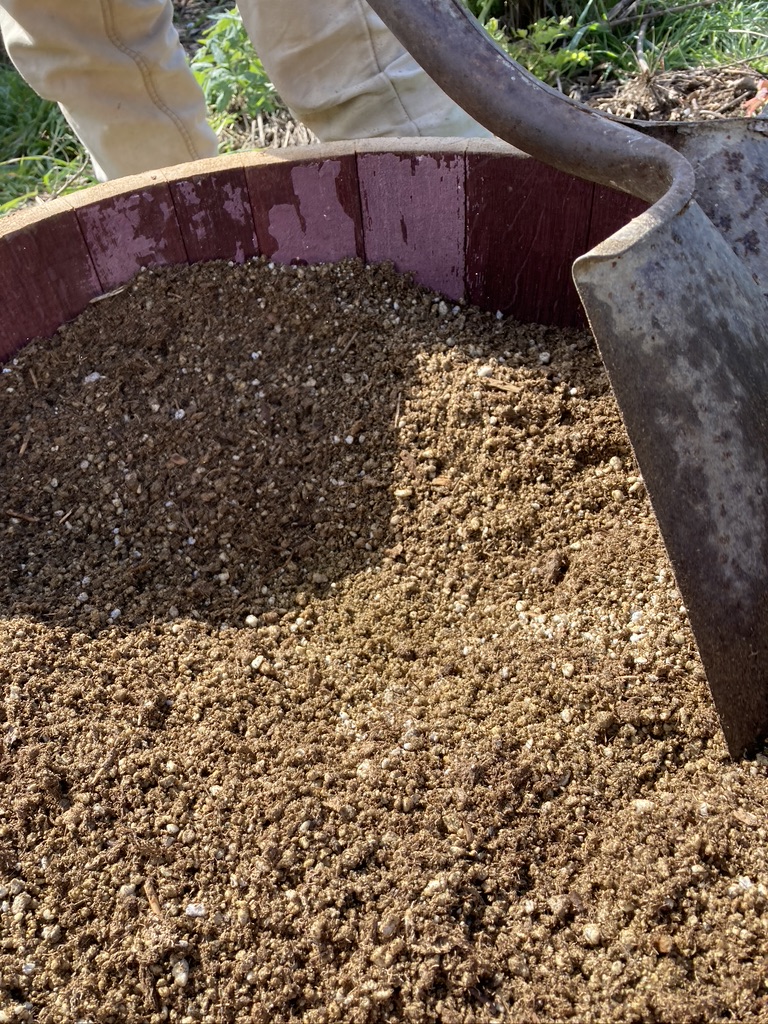
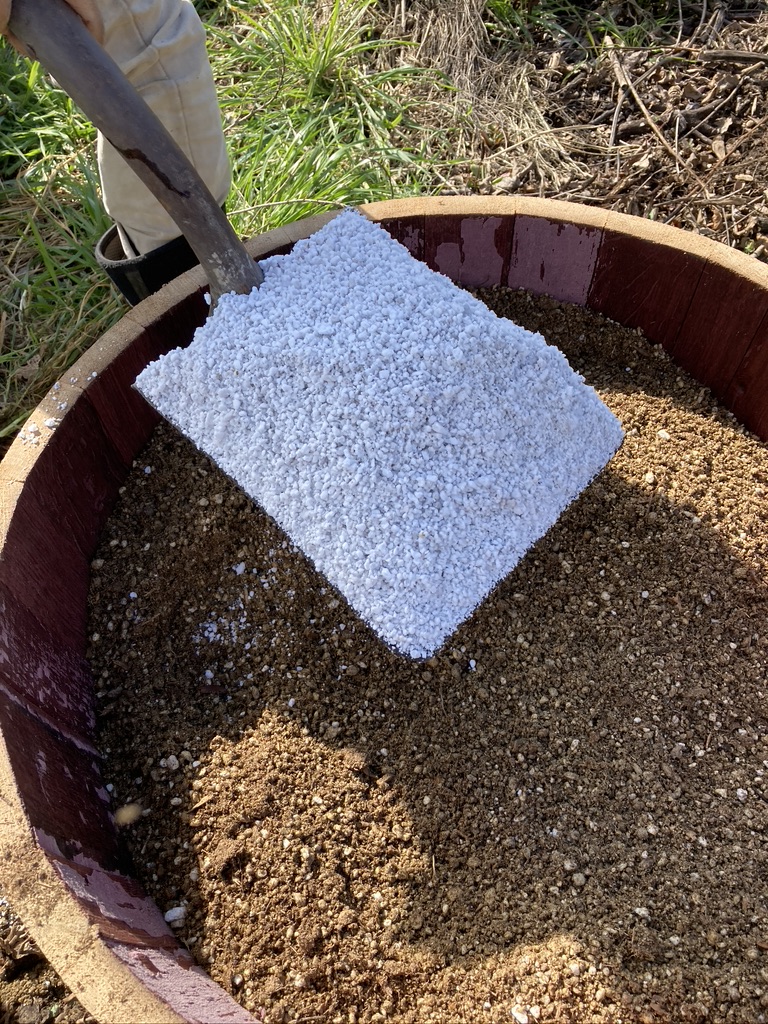
The tree we set into our pot was in a sleeve filled with wood-containing soil. We very carefully washed some of the wood away from the roots. Pretty much impossible to get rid of all the wood, but it should be only a short time before the roots have grown out beyond the initial ball, and into the special mix.
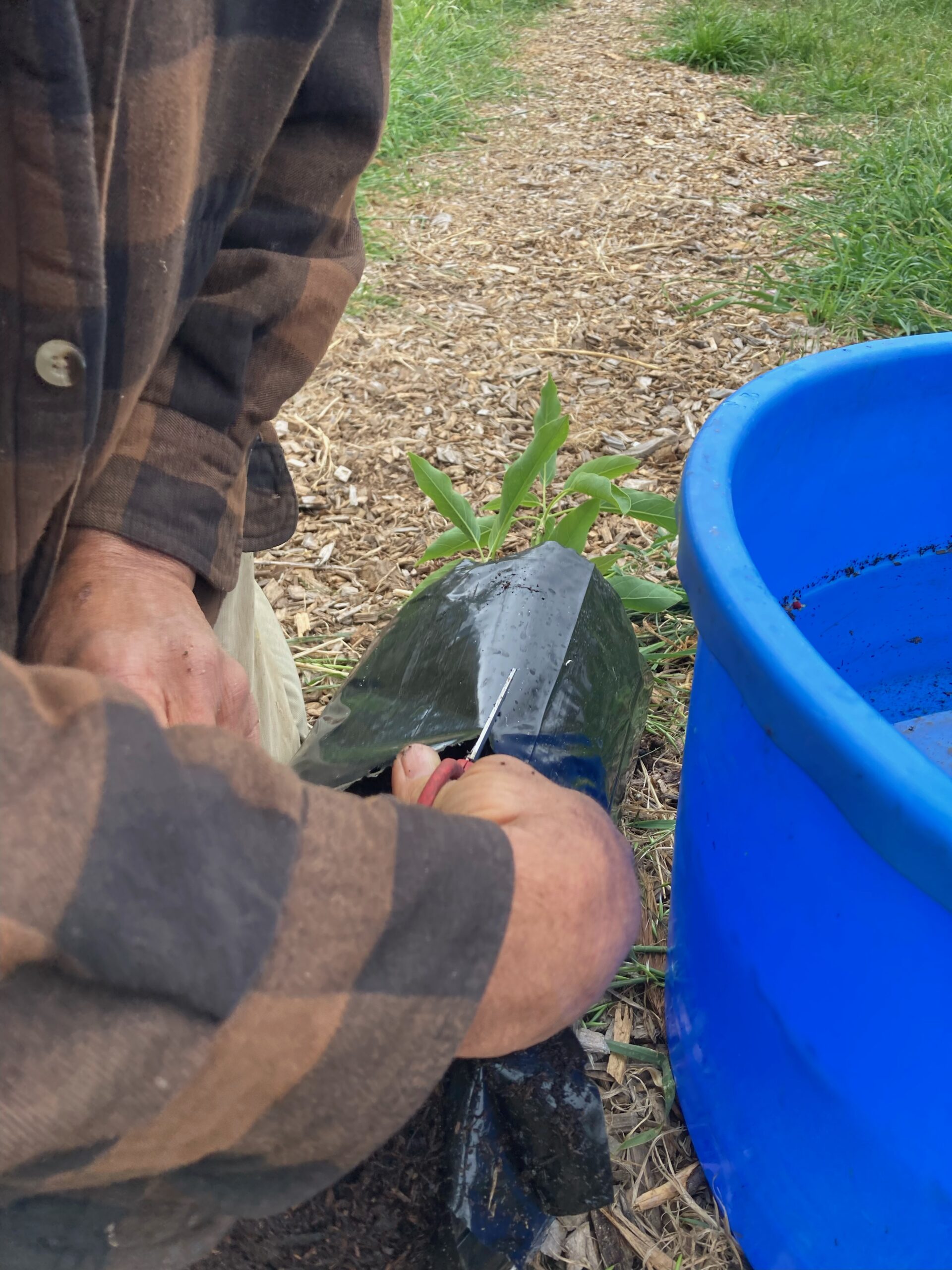
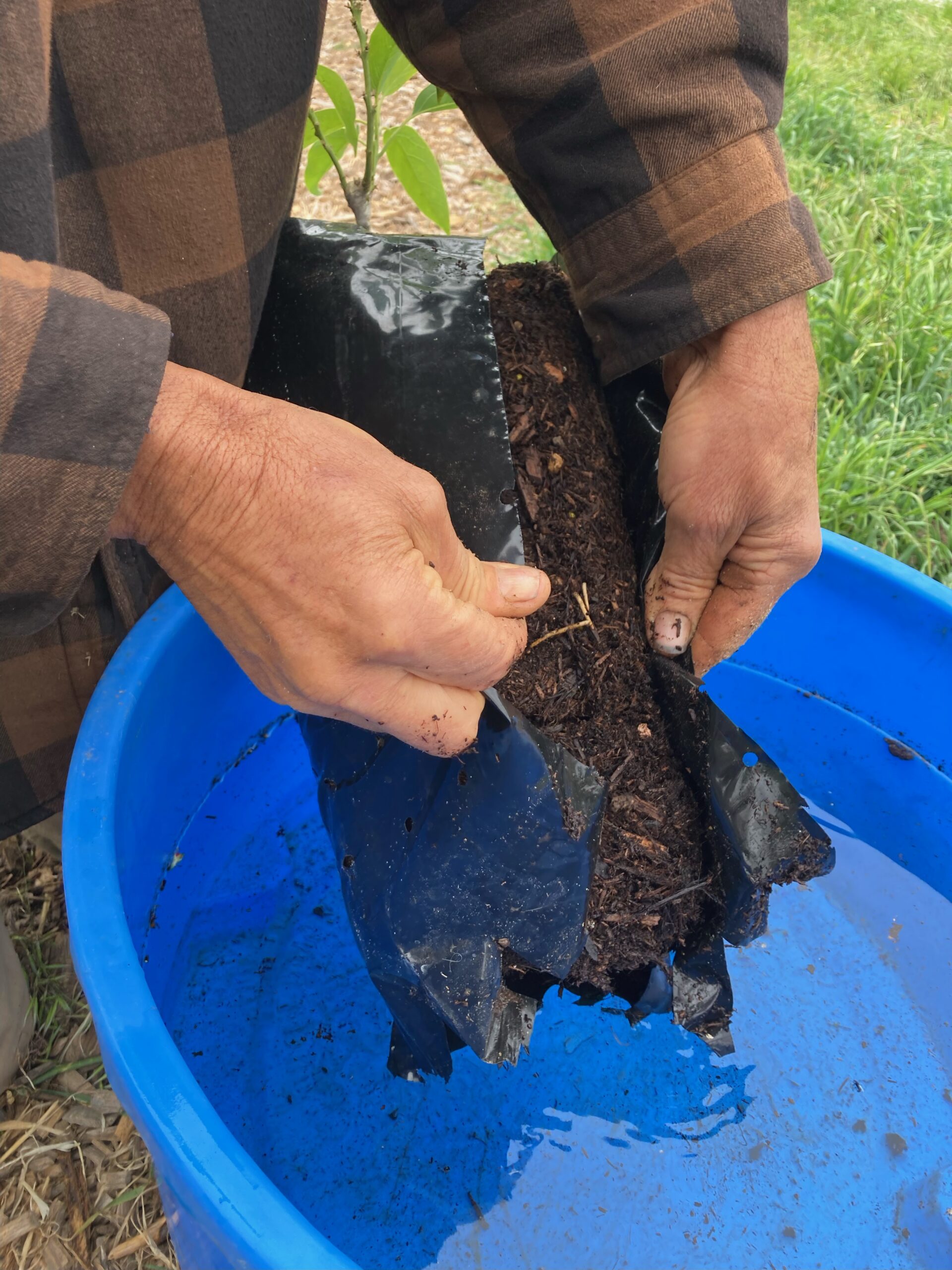
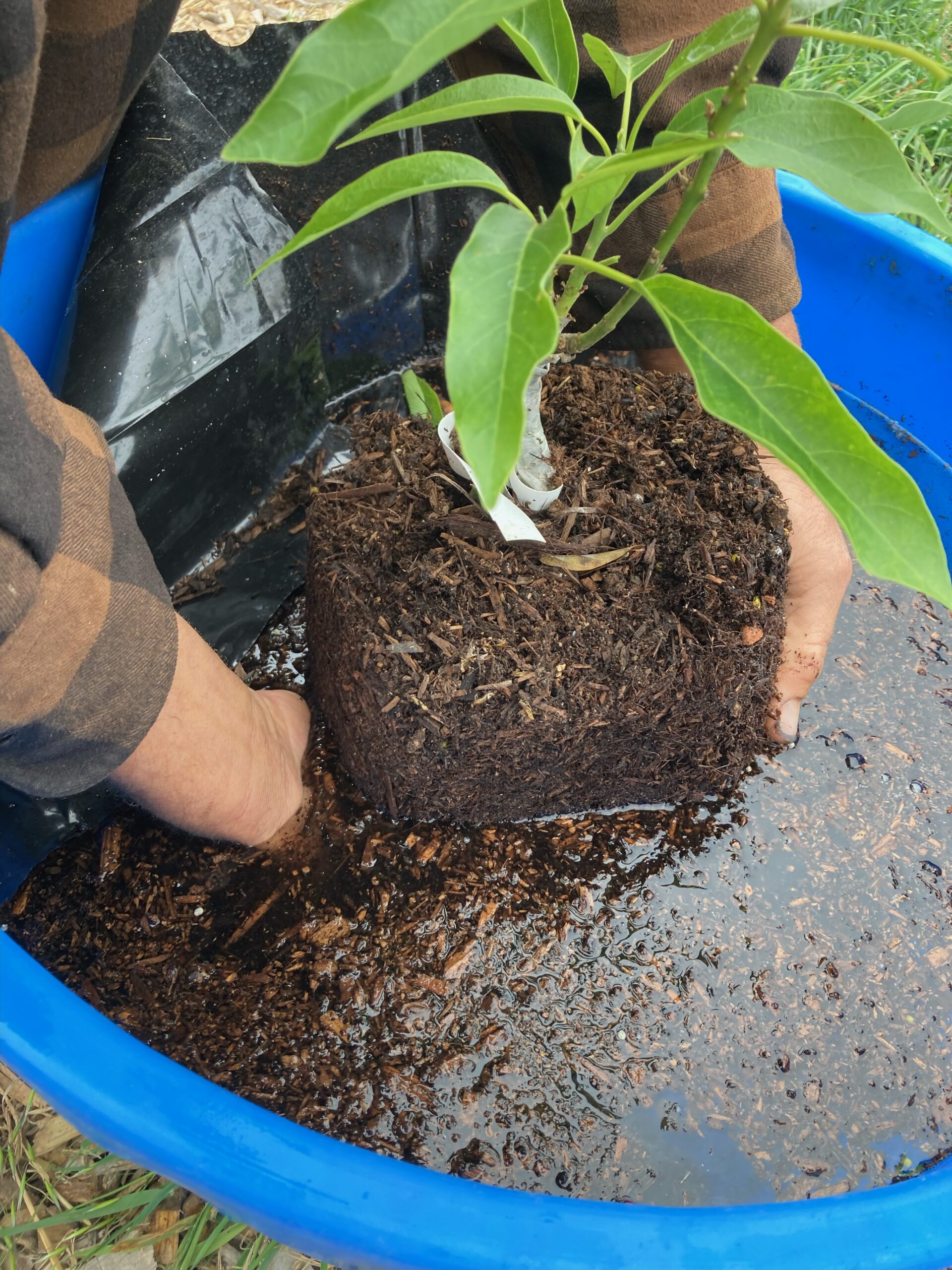
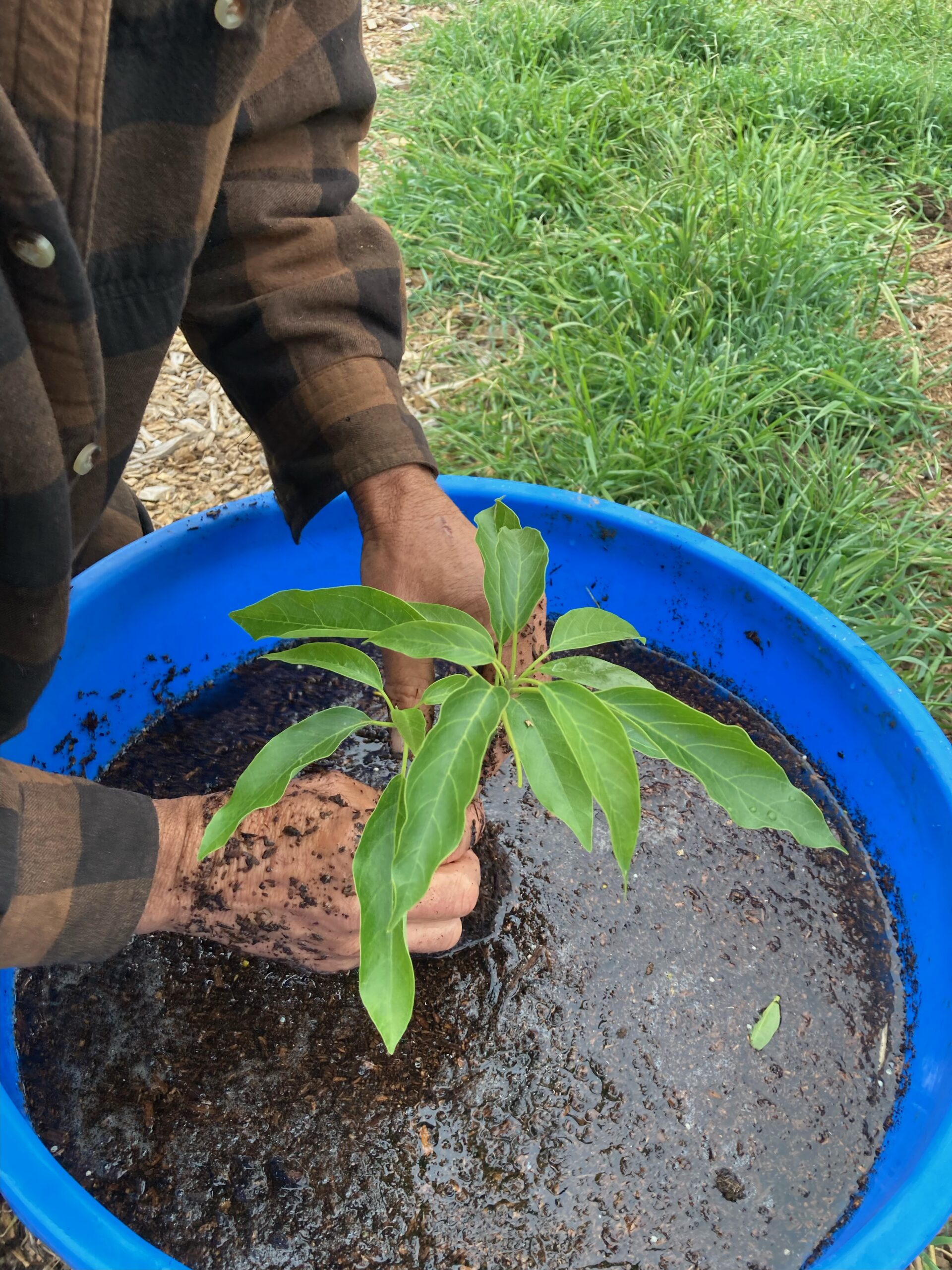
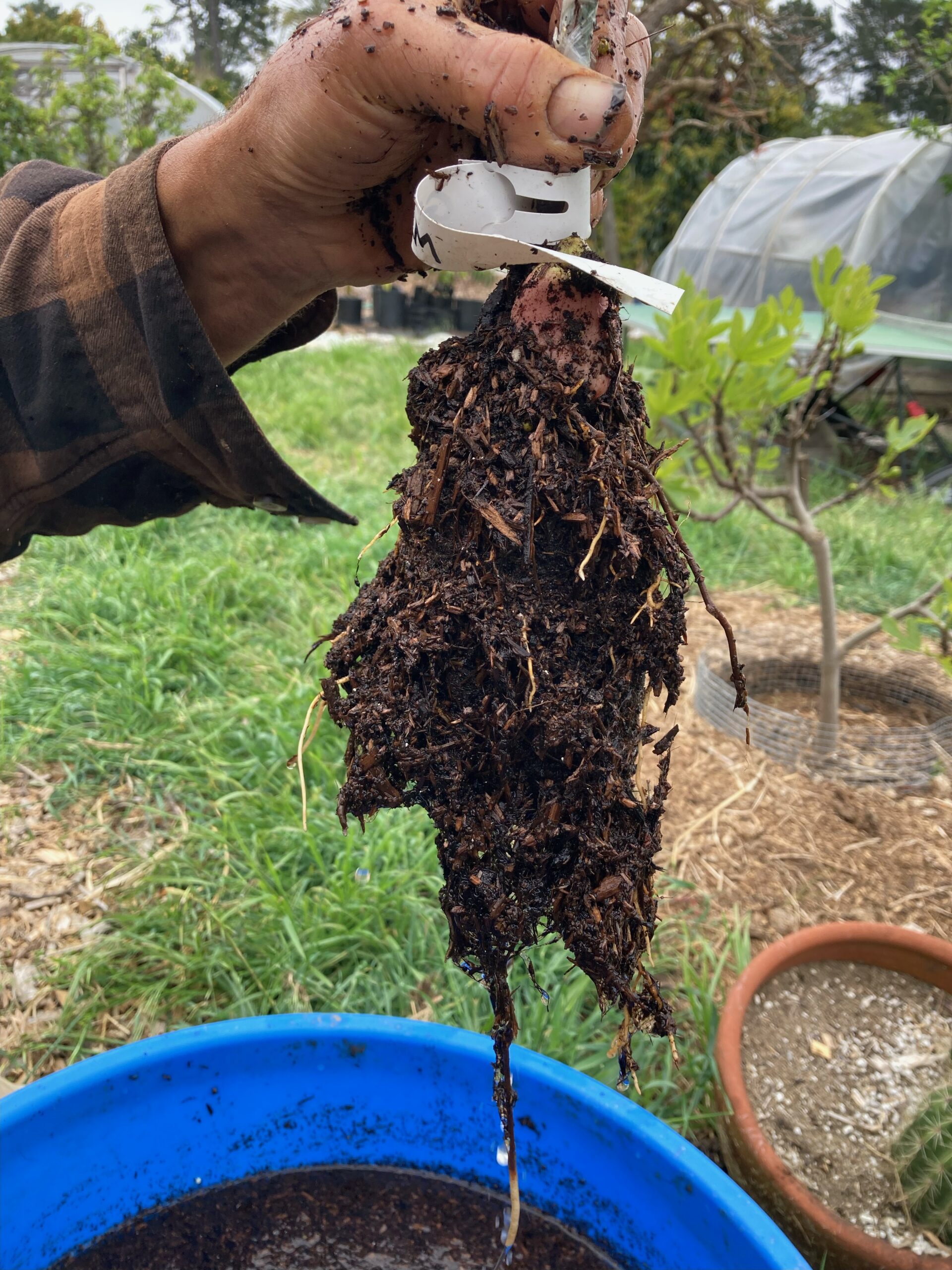
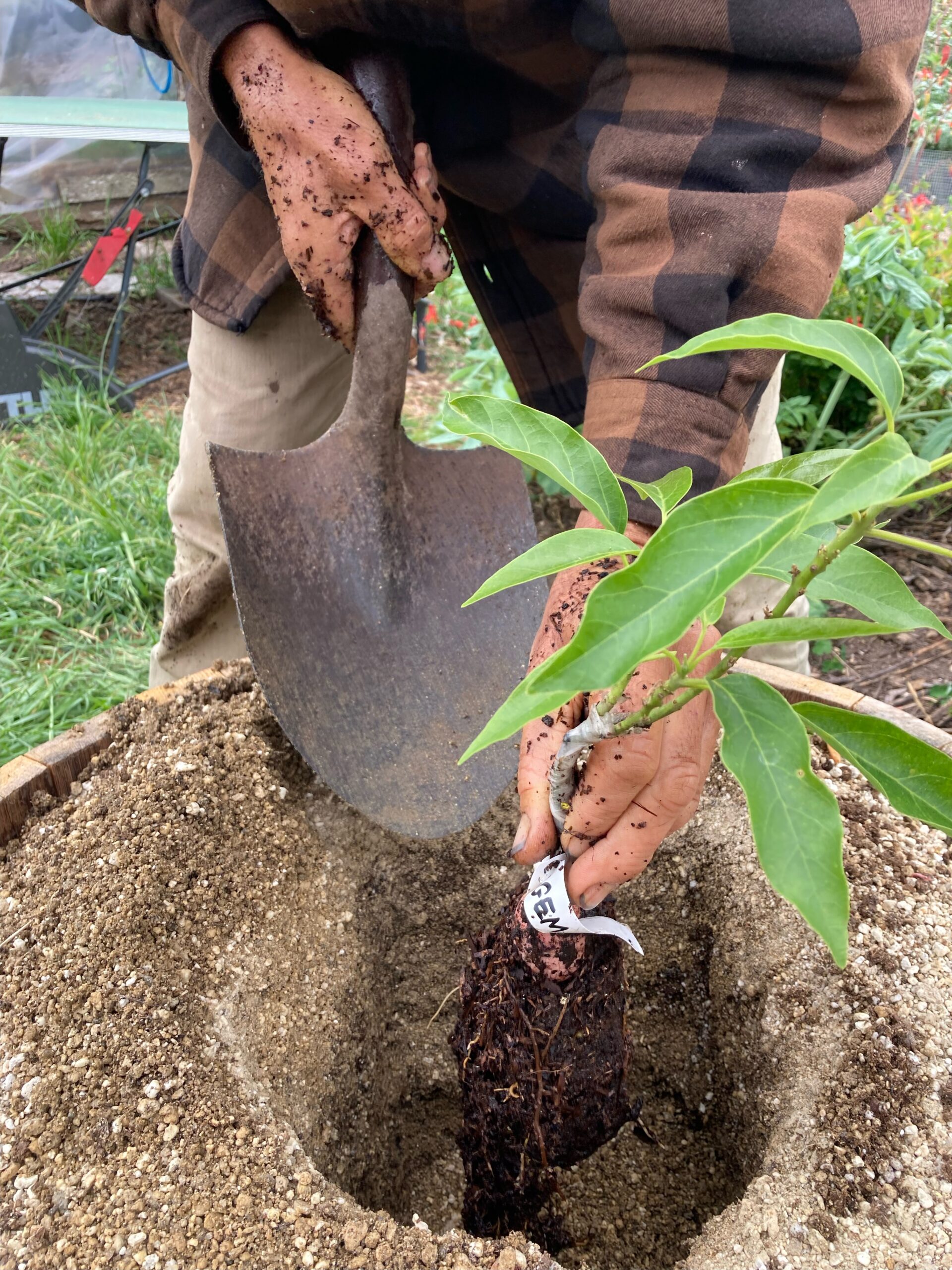
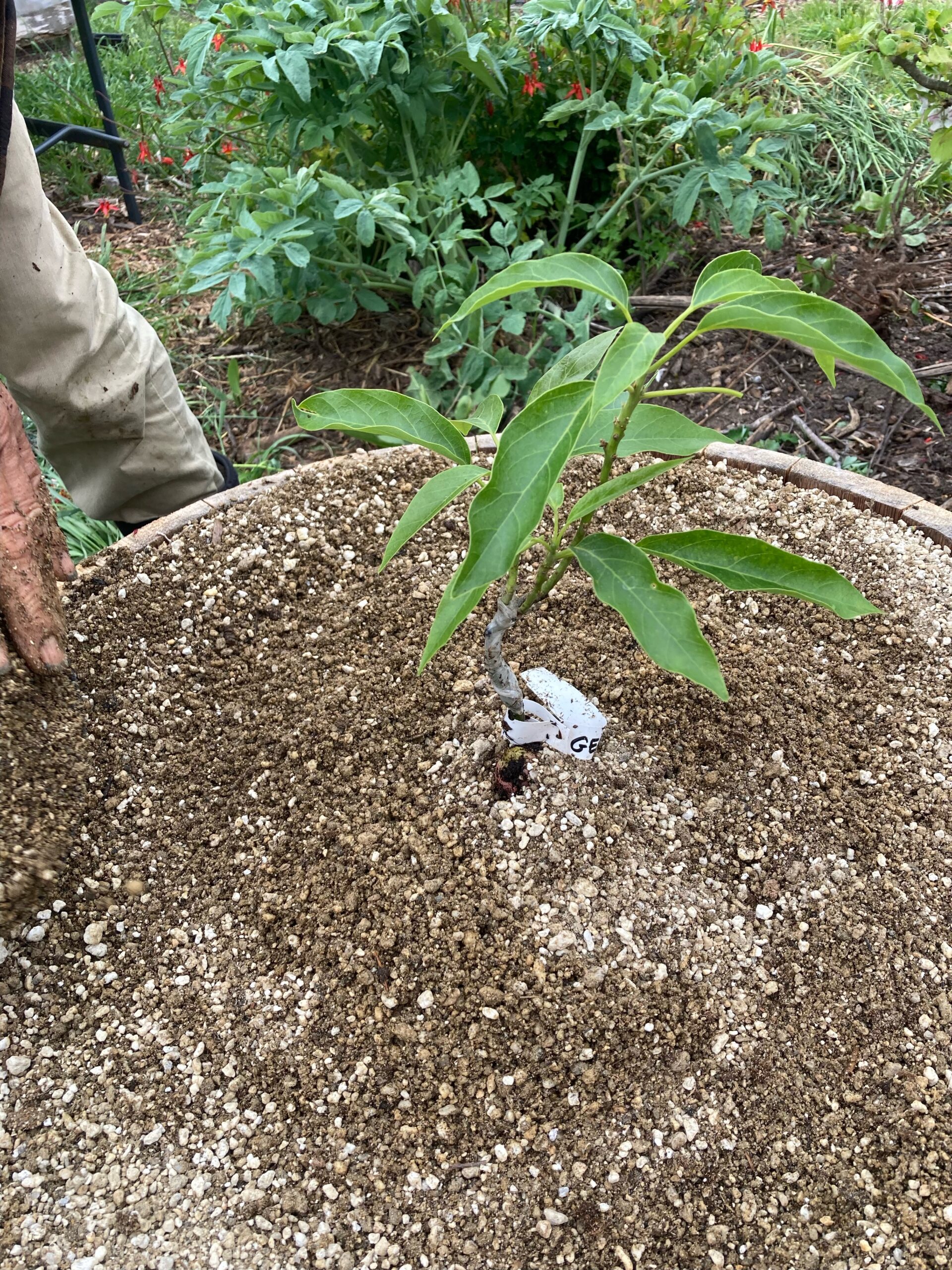
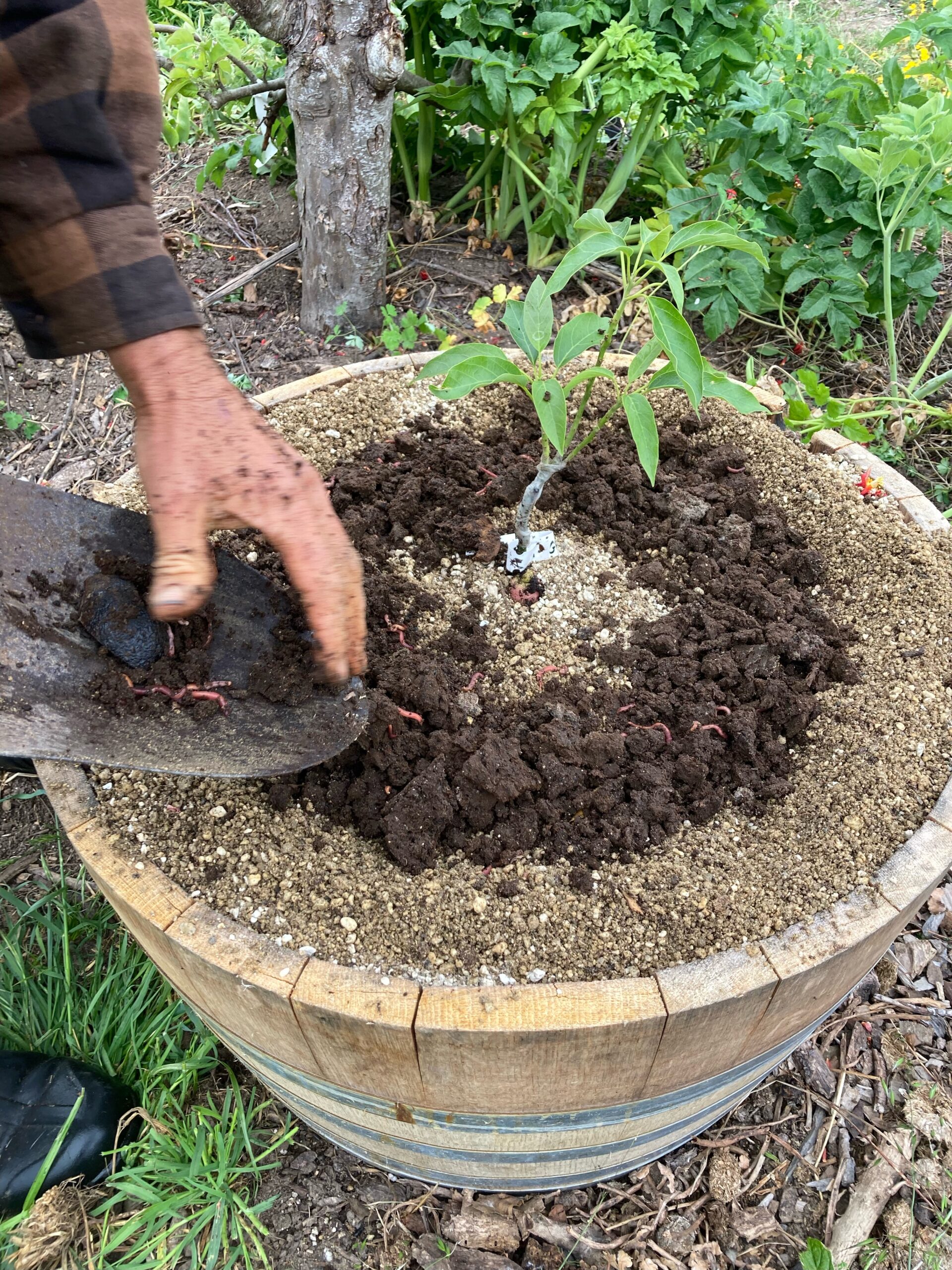
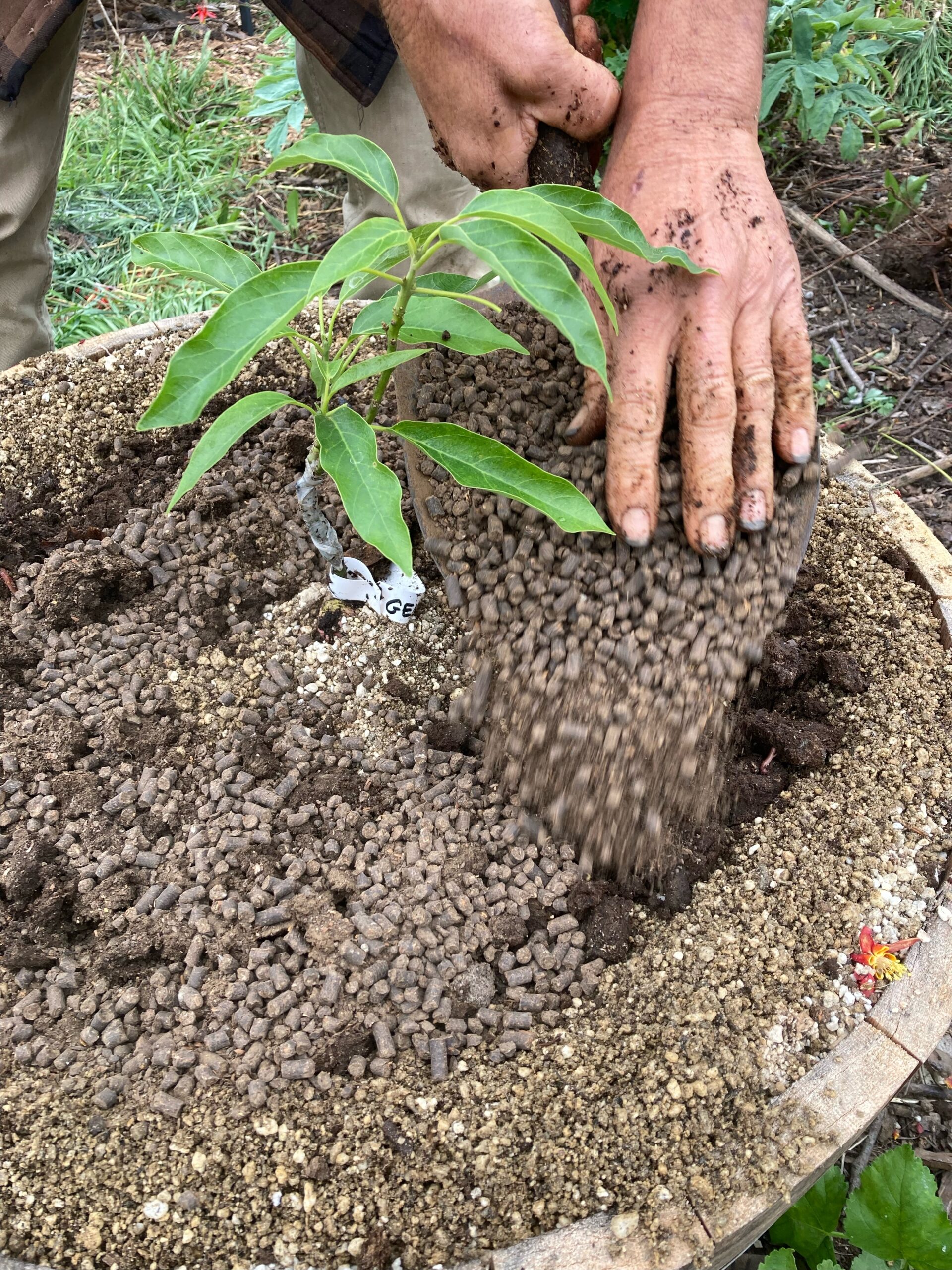
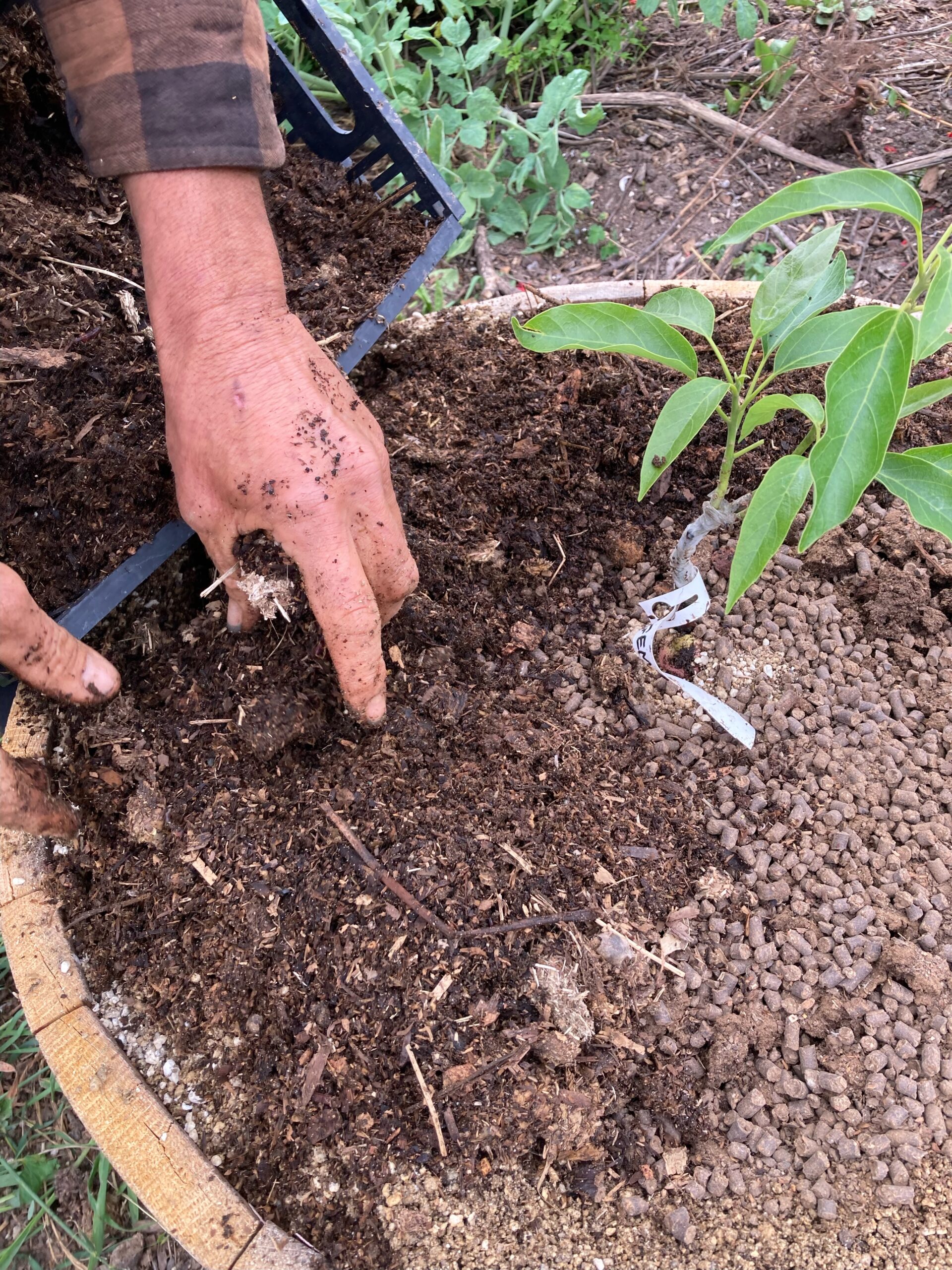
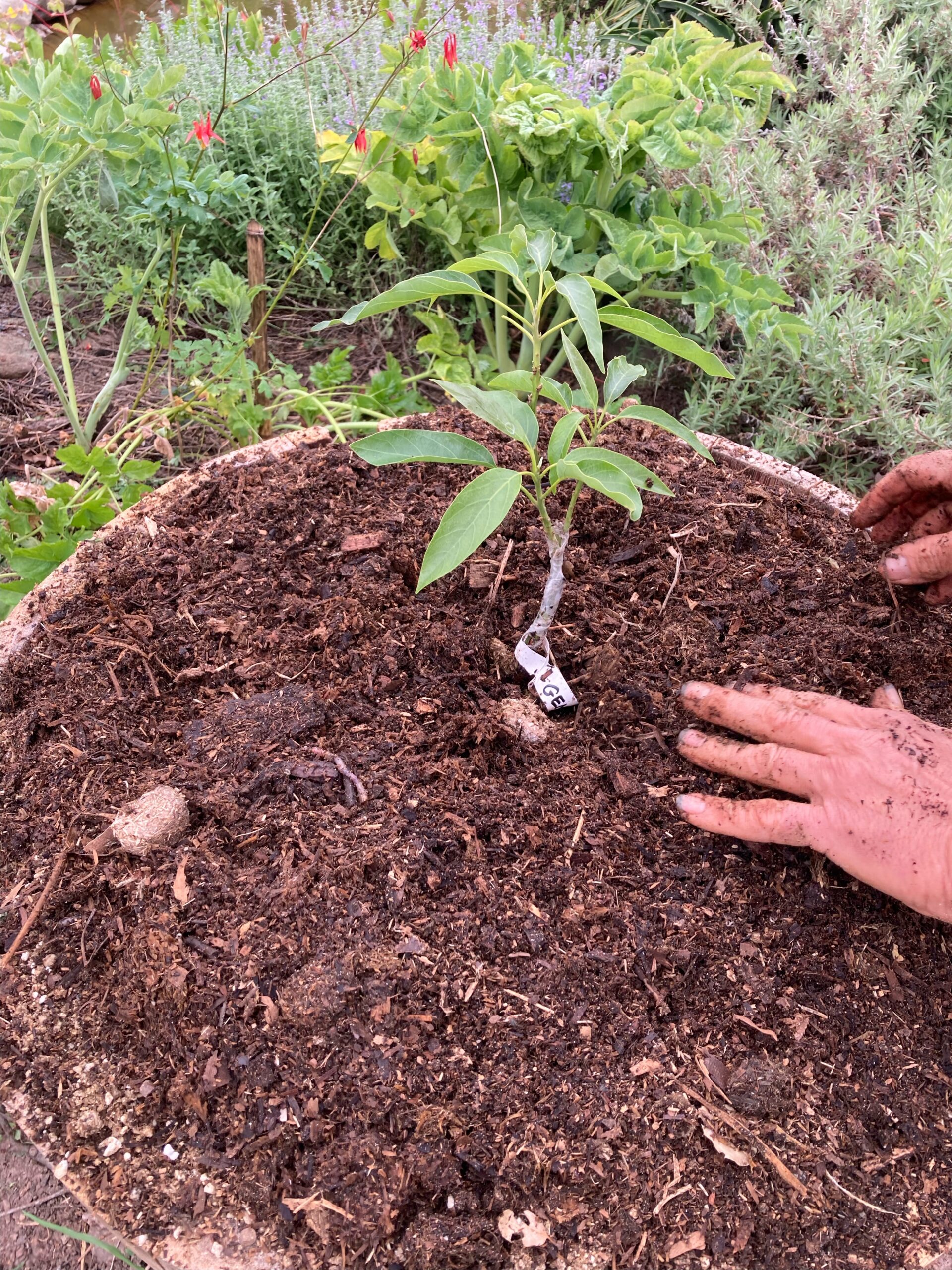
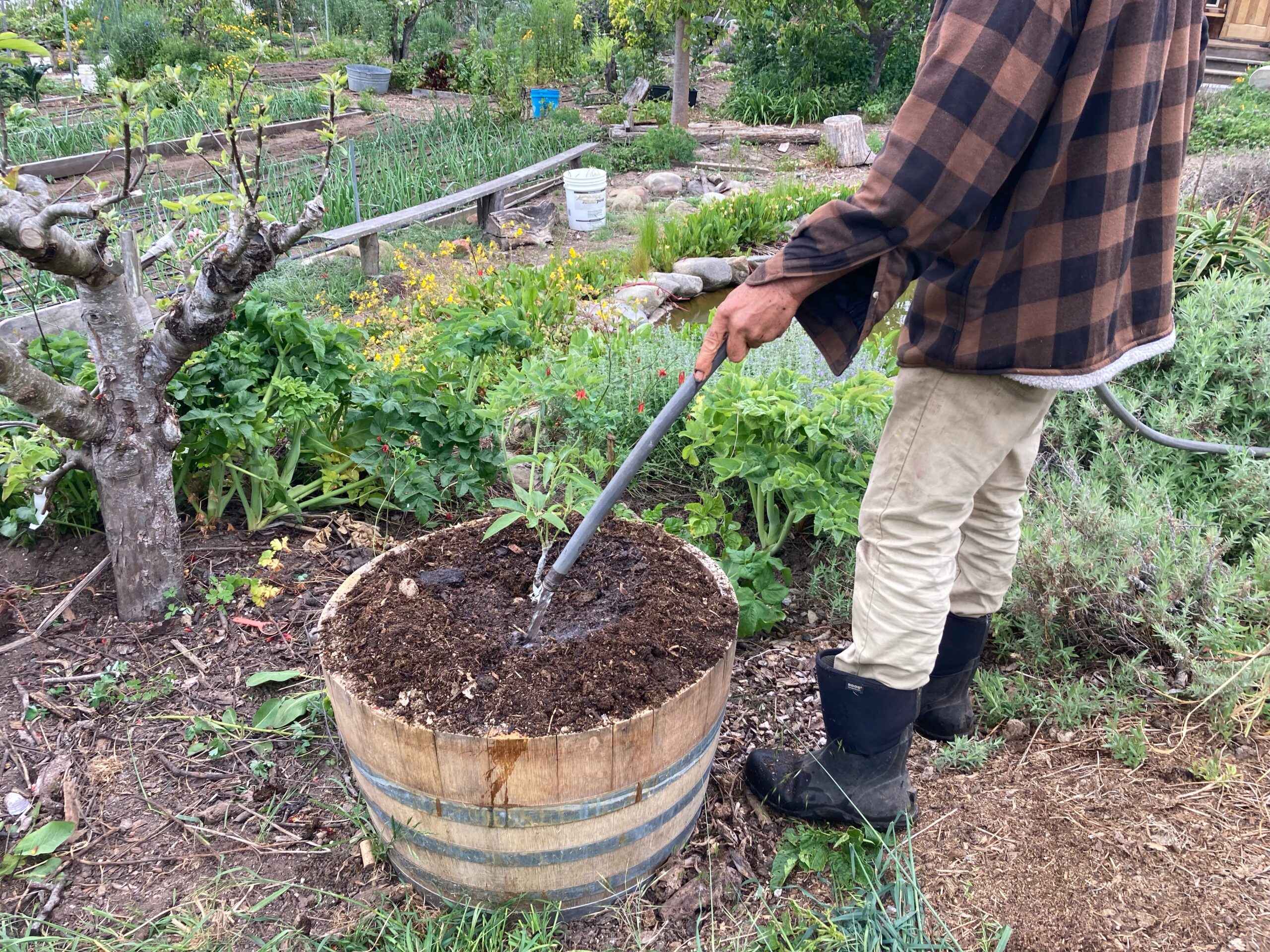
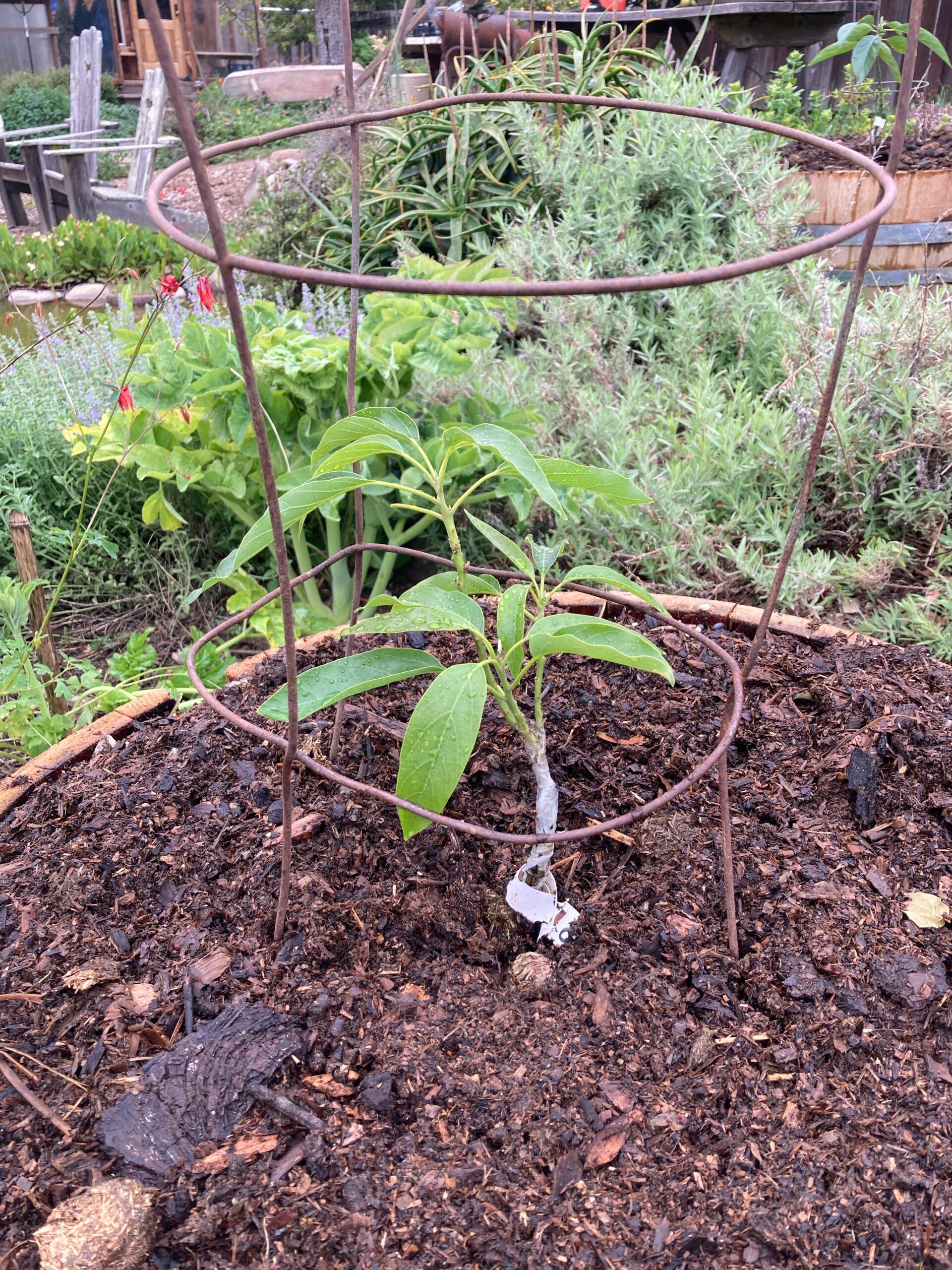
On the surface of the container, we placed a good blanket of composted horse manure over True 4-4-2 slow release fertilizer, gypsum, and worm castings.
We will water it about twice a week, and renew the fertility monthly.
We will try to include regularly updated photos of the progress our little tree makes, and inform you of adjustments called for in this little adventure into the realm of potted avocado culture.
In August, we decided that a thick layer of leafy wood chips would insulate the surface better than the matted horse manure.
The GEM was not thriving. We probably should have cut it back severely upon planting, but didn’t because it was so small in the first place. Mistake. It was also the third one on the property, so we pulled it out In August, and replaced it with a tiny Edranol.
At the end of March, after about eight months, we made some observations:
Partytime was planted in the second container we prepared, and went back and forth between happy and sickly for a while before we realized we needed to be pushing our trees harder.
As you can see, it responded well to weekly drenches of a strong tea made from composted chicken manure. We expected to see salt burn, but resolved to continue until evidence arose that the trees were being killed by our kindness. The signs never appeared, the Partytime responded with thickening stems and glossy leaves. At eight months, it looks solid and vigorous.
The Edranol, which was too tiny to cut back upon planting, has done almost nothing, but has gone from being completely static, to showing clear signs of elongating a fine new apical leaf cluster. We’ll stay on the manure tea drenches and see what April brings.

